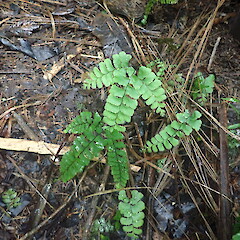Adiantum diaphanum
Common name
tuberous maidenhair, small maidenhair
Synonyms
Adiantum setulosum J.Smith, A. affine Hook. non Willd., A.polymorphum Colenso, A. diaphanum var. polymorphum (Colenso) Cheeseman, Adiantum tuberosum Colenso
Family
Pteridaceae
Flora category
Vascular – Native
Endemic taxon
No
Endemic genus
No
Endemic family
No
Structural class
Ferns
NVS code
The National Vegetation Survey (NVS) Databank is a physical archive and electronic databank containing records of over 94,000 vegetation survey plots - including data from over 19,000 permanent plots. NVS maintains a standard set of species code abbreviations that correspond to standard scientific plant names from the Ngä Tipu o Aotearoa - New Zealand Plants database.
ADIDIA
Chromosome number
2n = 232
Current conservation status
The conservation status of all known New Zealand vascular plant taxa at the rank of species and below were reassessed in 2017 using the New Zealand Threat Classification System (NZTCS) – more information about this can be found on the NZTCS website. This report includes a statistical summary and brief notes on changes since 2012 and replaces all previous NZTCS lists for vascular plants.
Please note, threat classifications are often suggested by authors when publications fall between NZTCS assessment periods – an interim threat classification status has not been assessed by the NZTCS panel.
- Conservation status of New Zealand indigenous vascular plants, 2017 . 2018. Peter J. de Lange, Jeremy R. Rolfe, John W. Barkla, Shannel P. Courtney, Paul D. Champion, Leon R. Perrie, Sarah M. Beadel, Kerry A. Ford, Ilse Breitwieser, Ines Schönberger, Rowan Hindmarsh-Walls, Peter B. Heenan and Kate Ladley. Department of Conservation. Source: NZTCS and licensed by DOC for reuse under the Creative Commons Attribution 4.0 International licence.
2017 | Not Threatened | Qualifiers: SO
Previous conservation statuses
2012 | Not Threatened
2009 | Not Threatened
2004 | Not Threatened
Distribution
Indigenous. New Zealand: Kermadec (Raoul Island), North Island (common from Te Paki to Waikato otherwise rather local), South Island (rather local reaching as far south as Dunedin), Chatham Islands. Also southern China, Japan, Taiwan, Vietnam. Malesia, Australia, Norfolk and Lord Howe Islands and the wider Pacific.
Habitat
Coastal to lowland in closed or open forest. Often on clay banks, under overhangs, on rubble slopes or along rocky stream sides.
Detailed description
Tufted, terrestrial fern. Rhizomes erect, c. 2 mm diameter; scales concolorous, golden brown, with entire margins and prominent apical seta. Roots and rootlets bearing ovoid proliferous tubers to c. 1.5 mm long. Fronds tufted, adaxially dark green, abaxially paler, to 360 mm long. Stipe to 180 mm long, smooth adaxially, scabrous abaxially. Lamina 20–170 × 20–130 mm, 1-pinnate, or 2–(3)-pinnate at the base and 1-pinnate above, subpedate, hastate or deltoid, membranous; rachises flexuous, glossy, glabrous. Basal pinna, when present, 1 or 2 (rarely more), narrowly deltoid, 1–2-pinnate. Pinnules dimidiate, rectangular to subtrapeziform, becoming cuneate-flabellate in apical segments, abaxially sparsely to very sparsely setose or glabrous, adaxially glabrous or setose hairy; distal margins shallowly lobed, denticulate when sterile; veins dark brown near stalk, otherwise pale. Sori 1–10 along distal margins, usually 1 per lobe; soral flaps round to subreniform, setose or glabrous, deeply immersed in the lobe. Spores c. 64 per sporangium, yellow, perine scabrous; largest diameter (25.6)–33.9–(51.9) μm.
Similar taxa
Easily distinguished by the tuberous roots and rootlets, and small, sparingly divided frond. It can be confused with diminutive forms of Adiantum hispidulum with which it sometimes grows and from which it is reliably distinguished by the tuberous rootlets.
Life cycle
Minute spores are wind dispersed (Thorsen et al., 2009).
Propagation technique
Easily grown in a shady site planted in a light, well-drained soil.
Etymology
adiantum: From the Greek a- ‘without, lacking’ and diantos ‘moistened’, the fronds of this fern are supposed to remain dry after submersion in water
diaphanum: From the Greek diaphanes, meaning transparent or filmy
Where to Buy
Not commercially available.
Attribution
Fact Sheet Prepared for NZPCN by P.J. de Lange (Updated 4 May 2011). Description adapted from Bostock (1998).
References and further reading
Bostock PD. 1998. Adiantaceae. Flora of Australia 48, Ferns Gymnosperms and allied groups: 248–263. ABRS/CSIRO Victoria, Australia.
Thorsen MJ, Dickinson KJM, Seddon PJ. 2009. Seed dispersal systems in the New Zealand flora. Perspectives in Plant Ecology, Evolution and Systematics 11: 285–309. https://doi.org/10.1016/j.ppees.2009.06.001.
NZPCN Fact Sheet citation
Please cite as: de Lange, P.J. (Year at time of access): Adiantum diaphanum Fact Sheet (content continuously updated). New Zealand Plant Conservation Network. https://www.nzpcn.org.nz/flora/species/adiantum-diaphanum/ (Date website was queried)



